In the Moment:
Michael Frye's Landscape Photography Blog
by Michael Frye | Feb 17, 2016 | Yosemite Photo Conditions
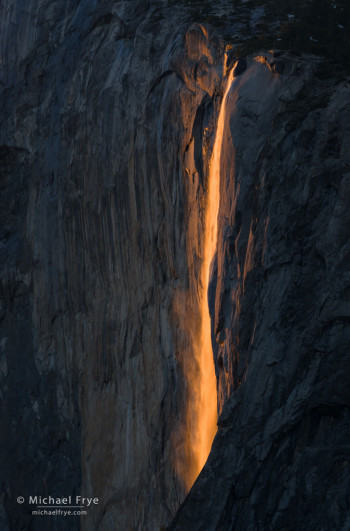
Horsetail Fall last night, 5:27 p.m.
February has been completely dry around here so far, with very warm temperatures. That warm weather has been melting the snow on top of El Capitan and creating a strong flow in Horsetail Fall – easily the most water in the fall since 2010. Yesterday was another clear, warm day (the high in Yosemite Valley was 67 degrees), with nearly ideal conditions for Horsetail. I wondered when I might see such conditions again, so I decided to head up to Yosemite Valley.
A first-hand look at Horsetail actually revealed less water than I expected. With the exceptionally warm weather we’ve been having I thought Horsetail would really be gushing, perhaps even approaching the high flow shown in this photograph from 1995. But nevertheless it was flowing well. I’d say the water level was a little above average for February (and, of course, way more than anything we’ve seen during the last four years of drought).
(more…)
by Michael Frye | Jan 20, 2016 | Yosemite Photo Conditions
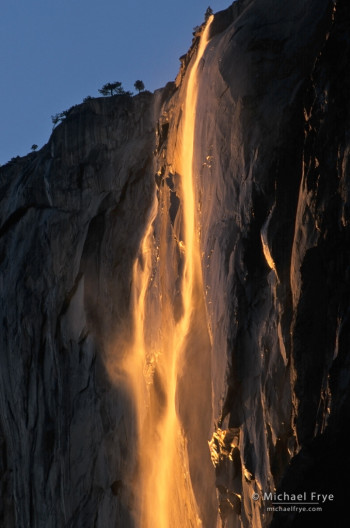
Horsetail Fall at sunset, Yosemite
We’re getting close to Horsetail Fall season, and I’m getting lots of questions about the water flow and the right time of year to photograph it.
As I said in my last post, there’s a healthy snowpack at higher elevations of Yosemite. Badger Pass ski area still reports 60 inches of snow on the ground at the base of the mountain (7,200 feet), and 72 inches at the top (8,000 feet). Horsetail’s small drainage on top of El Capitan lies at similar elevations, but faces south, and the slopes of Badger Pass face north. That means Horsetail’s drainage gets more sun, and the snow melts faster. But there should still be at least three or four feet of snow on top of El Cap right now, and it’s hard to imagine how all of that could melt between now and the third week of February. After four years of drought, it looks like we’ll finally have a good flow in Horsetail Fall at the right time of year.
But water flow is just one element. You also need the sun to set at the right angle to backlight Horsetail and make it turn orange, yet have the cliff behind it in the shade, so that the glowing, backlit, orange water is set against a dark background. My best estimate is that this happens between February 16th and 23rd, and perhaps even a few days beyond. (I delve into more detail about all that here.)
(more…)
by Michael Frye | Feb 22, 2015 | Yosemite Photo Conditions
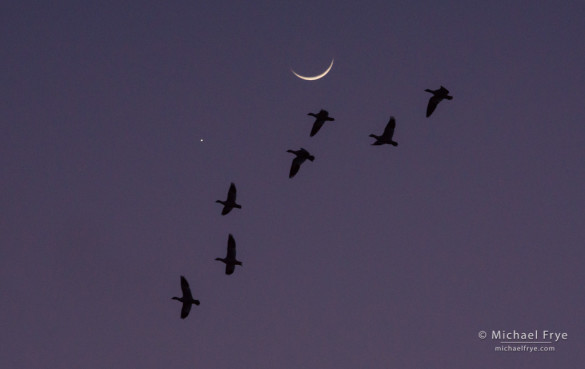
Moon, Venus, and Ross’s geese, San Joaquin Valley, CA, USA
I’ve been working on a book deadline, so haven’t been able to get to Yosemite Valley and check on Horsetail Fall recently. But I did break away from the desk on Friday to go down to the Central Valley and photograph birds. At first the light was rather uninspiring, because the fog I was hoping for had lifted into a low overcast. But it turned out to be a great day. I photographed one of the biggest goose takeoffs I’ve ever seen, with perhaps 30,000 birds lifting off at once; one of the photographs below shows part of that group. Later, the sun broke through the stratus deck to create some beautiful sunbeams, and at dusk Venus and the crescent moon appeared (above).
As for Horsetail, the flow diminished quickly after the last rainstorm, and from reports I’ve heard there is basically no water in it – just a bit of dampness. There is another storm predicted for today and tomorrow. This is expected to be both colder and weaker than the last storm, with snow levels around 6,000 feet, but limited moisture. Horsetail might get some help from this system, but probably not much. Even if this storm turns out to be bigger than predicted, any precipitation in Horsetail’s drainage will fall as snow, so there won’t be a significant boost in flow until the sun comes out and melts some of that snow. It’s supposed to be sunny Tuesday, Wednesday, and Thursday, so maybe by Wednesday or Thursday we could see a decent water flow in Horsetail.
(more…)
by Michael Frye | Feb 6, 2015 | Yosemite Photo Conditions
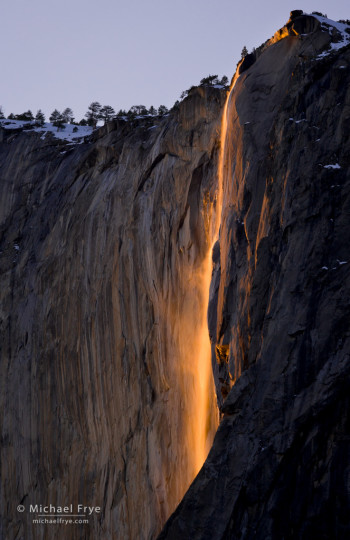
This photograph from 2009 shows what an average February flow in Horsetail Fall looks like
After a wet spell in December, the rain spigot got turned off. Yosemite Valley received seven one-hundredths of an inch of rain for the entire month of January. San Francisco set a record for January that can never be broken, with no measurable precipitation.
Not surprisingly, there isn’t much water in Horsetail Fall. In fact there’s no detectable flow at all – just a little dampness near the top. But forecasters are predicting a significant storm this weekend. They’re actually expecting two pulses, one tonight, and another on Sunday night. Total rainfall for the weekend could exceed four inches if the forecasts are right.
Horsetail should get a short-term boost from this storm. Whether that boost lasts longer depends on the exact snow level. Horsetail is fed by melting snow from a small drainage on top of El Capitan lying between 6,200 and 7,600 feet. The predictions for this storm put the snow level at 8,000 feet. If the actual snow levels are a little lower, and Horsetail’s tiny watershed gets some significant snow, then the runoff from that snow melting could last for a couple of weeks and provide at least some flow during the prime photography period later this month. If the snow levels are higher, and Horsetail’s drainage gets only rain, the water will run off quickly and won’t provide a lasting increase in the flow.
(more…)
by Michael Frye | Feb 18, 2014 | Yosemite Photo Conditions
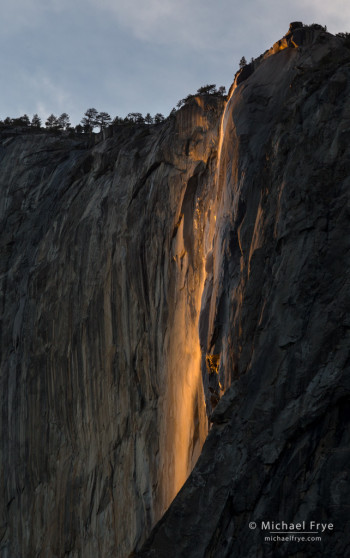
Horsetail Fall just before sunset, Sunday evening, 5:28 p.m.
Yosemite got some showers on Saturday night, which helped to add a little water to Horsetail and create a decent flow – below average, but probably better than anything I’ve seen the last two years.
Sunday evening a workshop student and I joined the throngs of photographers near the El Capitan picnic area. Some thin clouds muted the the light a bit, and then thicker clouds cut the light off entirely just before it would have reached its peak intensity and color, and before the cliff behind the fall was in complete shade. But Horsetail still put on a good show, as you can see from the accompanying photo, made at 5:28 p.m.
Unfortunately the little boost in water level from Saturday’s showers probably won’t last long, and a hoped-for storm tonight and tomorrow now looks like it will bring only a slight chance of showers. I think Horsetail will keep flowing for at least the next week, but the flow will probably be pretty meager. Still, it doesn’t take much. With a clear sunset even a little bit of water can turn into a strip of neon orange. I’d guess the water flow will be similar to 2012; you can see what that looked like in this post from that year.
It now looks like the rest of February is likely to be dry. We really need a miracle March!
— Michael Frye
Related Posts: Another Clearing Storm, and a Horsetail Fall Forecast; Quick Horsetail Update
(more…)













